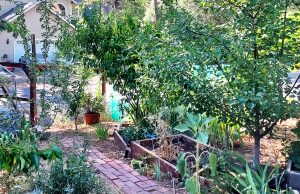Life is full of difficult decisions. What kind of trees for my new home orchard and where to plant them? How big could I afford to let them grow? I dreamt of gallons of apple cider; I also remembered a dear friend’s fall from an orchard ladder. A full-sized apple tree can grow to over 30 feet tall. Even on dwarf root stock an apple tree can easily grow 20 feet in height. My dilemma? I don’t really need gallons of cider. A mature standard apple tree will produce 1500 apples. That is a LOT of compost (I can’t imagine doing all that work). A dwarf apple can produce between 150 to 300 apples; that’s more my size!
Fruit trees don’t grow as small as I want, “high as I can reach with my lopping shears, standing on the ground,” no ladders. That takes summer pruning. According to one university study I read, winter pruned trees have enough stored energy in their root system to support their original size and still grow some more. Summer pruning manages that excess energy and keeps the tree small. Growth of a fruit tree begins at bud break in early spring and continues until summer solstice or late June. There is a pruning balancing act, though; trees need energy to produce fruit. With many trees, summer pruning is fairly simple; prune after fruit harvest. That will not work for late harvest trees like apples and pears. For these trees, prune just after trees have blossomed. (Some trees, such as cherry and apricot, should always be pruned in summer after harvest. You are inviting all sorts of disease to the open wounds if you prune in winter.)
Summer or winter, reasons for pruning remain the same. Pruning structures, the tree to provide even access to sun and ventilation, prevents disease and provides strong growth. It rejuvenates the tree and develops fruiting wood on lower branches. Summer pruning does not replace all winter pruning. In winter, branches are bare which makes it easier to see how to create shape and structure.
There are basically two types of cuts used in all pruning, heading and thinning cuts. “Heading” cuts a branch back. The cut should be made at a 45-degree angle and about ¼ inch above an outward facing bud. Cutting to an inward bud will result in crossing branches. This type of cut often results in vigorous growth, especially early in the year. “Thinning” removes lateral branches. Look closely and you will see a collar where the branch emerges. Angle your cut far enough away from the parent branch so you do not damage the collar.
Most of us are pretty nervous about pruning. Remember, you cause more damage to your tree by not pruning than by making pruning mistakes. The only problem with a dwarf orchard? The minute you stop pruning the tree starts growing. A few years ago, I visited a nursery’s home orchard demonstration. They warned me that summer pruning had stopped. The trees were all overgrown and over 20 feet tall. I guess the moral of the story is simple. Fruit trees are a lot of work. You either prune or get swallowed up in a sea of new growth with a lot of tiny fruit!
Jim Bliss is a University of California Cooperative Extension Master Gardener of Tuolumne County

